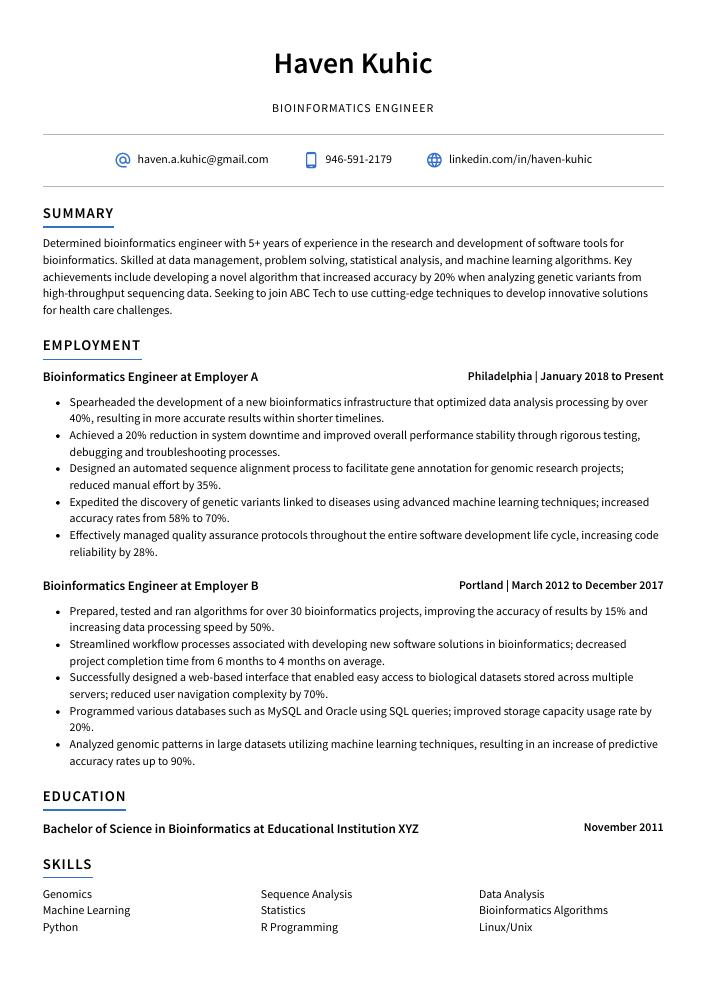Bioinformatics Engineer Resume Guide
Bioinformatics Engineers are responsible for developing and managing databases of biological information, analyzing data using software programs and algorithms, designing experiments to test hypotheses about the structure or behavior of living organisms, and creating models. They also use their expertise in computer programming to develop new tools that allow researchers to analyze complex datasets.
You have the skills to take on any bioinformatics engineering project, but employers don’t know who you are. To make them aware of your talents and qualifications, you need a resume that captures their attention.
This guide will walk you through the entire process of creating a top-notch resume. We first show you a complete example and then break down what each resume section should look like.
Table of Contents
The guide is divided into sections for your convenience. You can read it from beginning to end or use the table of contents below to jump to a specific part.
Bioinformatics Engineer Resume Sample
Haven Kuhic
Bioinformatics Engineer
[email protected]
946-591-2179
linkedin.com/in/haven-kuhic
Summary
Determined bioinformatics engineer with 5+ years of experience in the research and development of software tools for bioinformatics. Skilled at data management, problem solving, statistical analysis, and machine learning algorithms. Key achievements include developing a novel algorithm that increased accuracy by 20% when analyzing genetic variants from high-throughput sequencing data. Seeking to join ABC Tech to use cutting-edge techniques to develop innovative solutions for health care challenges.
Experience
Bioinformatics Engineer, Employer A
Philadelphia, Jan 2018 – Present
- Spearheaded the development of a new bioinformatics infrastructure that optimized data analysis processing by over 40%, resulting in more accurate results within shorter timelines.
- Achieved a 20% reduction in system downtime and improved overall performance stability through rigorous testing, debugging and troubleshooting processes.
- Designed an automated sequence alignment process to facilitate gene annotation for genomic research projects; reduced manual effort by 35%.
- Expedited the discovery of genetic variants linked to diseases using advanced machine learning techniques; increased accuracy rates from 58% to 70%.
- Effectively managed quality assurance protocols throughout the entire software development life cycle, increasing code reliability by 28%.
Bioinformatics Engineer, Employer B
Portland, Mar 2012 – Dec 2017
- Prepared, tested and ran algorithms for over 30 bioinformatics projects, improving the accuracy of results by 15% and increasing data processing speed by 50%.
- Streamlined workflow processes associated with developing new software solutions in bioinformatics; decreased project completion time from 6 months to 4 months on average.
- Successfully designed a web-based interface that enabled easy access to biological datasets stored across multiple servers; reduced user navigation complexity by 70%.
- Programmed various databases such as MySQL and Oracle using SQL queries; improved storage capacity usage rate by 20%.
- Analyzed genomic patterns in large datasets utilizing machine learning techniques, resulting in an increase of predictive accuracy rates up to 90%.
Skills
- Genomics
- Sequence Analysis
- Data Analysis
- Machine Learning
- Statistics
- Bioinformatics Algorithms
- Python
- R Programming
- Linux/Unix
Education
Bachelor of Science in Bioinformatics
Educational Institution XYZ
Nov 2011
Certifications
Bioinformatics Certification
Bioinformatics Certification Institute
May 2017
1. Summary / Objective
A resume summary or objective is a great way to introduce yourself as a bioinformatics engineer. Here, you can highlight your experience in developing algorithms and software for analyzing large datasets, the various programming languages you are proficient in, and any relevant certifications or awards that demonstrate your expertise. You should also mention how you have used data analysis techniques to solve complex problems at previous companies; this will show potential employers that you possess the skills necessary to be successful in their role.
Below are some resume summary examples:
Accomplished bioinformatics engineer with 5+ years of experience in research and development, data analysis, and algorithm design. Seeking to join ABC Tech’s team to bring cutting-edge bioinformatics solutions for the unique basket of clients within its global reach. In previous roles developed a new machine learning model that improved accuracy by 15%. Effectively collaborated across teams including engineers, scientists, and developers to complete projects on time.
Detail-oriented bioinformatics engineer with a strong background in software engineering and extensive experience developing next-generation sequencing (NGS) data analysis pipelines. At XYZ, developed an algorithm that reduced pipeline runtime by 80%. Also created several databases for managing NGS data from multiple sources. Looking to leverage my skills at ABC company to develop innovative bioinformatic solutions for the healthcare industry.
Seasoned bioinformatics engineer with 8+ years of experience developing and deploying data-driven solutions to solve complex biological problems. Expertise in programming languages such as Python, Java, C/C++ and SQL. At XYZ Inc., developed a bioinformatics platform that increased the accuracy of genomic analysis by 30%. Also have extensive knowledge in machine learning algorithms for pattern recognition applications.
Energetic and knowledgeable bioinformatics engineer with 5+ years of experience in developing and maintaining software solutions for analyzing large genomic datasets. At XYZ, developed a web-based application to process over 10 million records per day. Skilled at designing efficient algorithms, creating intuitive user interfaces and visualizing data to assist researchers in understanding complex biological processes.
Proficient bioinformatics engineer with 5+ years of experience in developing, testing and deploying complex bioinformatic software applications. Expertise includes leveraging advanced technologies such as machine learning and artificial intelligence to analyze biological data sets. Proven track record of providing innovative solutions that increase accuracy while reducing costs associated with the analysis process.
Driven bioinformatics engineer with 5+ years of experience leveraging data science and programming to develop insights from large datasets. Skilled in developing algorithms, designing models, and creating software solutions to support biological research efforts. Seeking a position at ABC Company where I can leverage my expertise to drive innovation in the field of bioinformatics engineering.
Passionate bioinformatics engineer with 7+ years of experience in data analysis and software engineering. Skilled in developing algorithms, creating databases, and producing reports for complex biological datasets. Seeking to join ABC Tech as a bioinformatics engineer to leverage my expertise in building innovative solutions that enable the company’s success on an international level.
Skilled bioinformatics engineer with 5+ years of experience in data analysis, visualization, and interpretation. Experienced in developing custom pipelines to process large genomic datasets using scripting languages such as Python and R. Seeking a position at ABC where I can leverage my expertise in analyzing biological data to help drive innovation within the company.
2. Experience / Employment
The employment (or experience) section is where you talk about your work history. It should be written in reverse chronological order, which means that the most recent job is listed first.
When writing this section, use bullet points primarily; doing so makes it easier for the reader to take in what you have to say quickly and easily. When stating what you did, provide detail by explaining how you achieved results or overcame obstacles.
For example, instead of saying “Developed bioinformatics software,” try something like: “Designed a suite of bioinformatics tools for analyzing gene sequences from different species with accuracy and speed – resulting in an 80% reduction in analysis time.”
To write effective bullet points, begin with a strong verb or adverb. Industry specific verbs to use are:
- Analyzed
- Programmed
- Automated
- Simulated
- Optimized
- Developed
- Implemented
- Constructed
- Monitored
- Investigated
- Interpreted
- Visualized
- Assessed
- Designed
- Processed
Other general verbs you can use are:
- Achieved
- Advised
- Compiled
- Coordinated
- Demonstrated
- Expedited
- Facilitated
- Formulated
- Improved
- Introduced
- Mentored
- Participated
- Prepared
- Presented
- Reduced
- Reorganized
- Represented
- Revised
- Spearheaded
- Streamlined
- Structured
- Utilized
Below are some example bullet points:
- Formulated algorithms to extract, analyze and interpret large datasets using bioinformatics tools such as Python, R and MATLAB; increased data processing speed by 33%.
- Reorganized existing databases to improve searchability of target gene sequences which led to the discovery of 4 new genes related to disease diagnosis.
- Introduced novel artificial intelligence models for image recognition algorithms resulting in improved accuracy rates from 70% to 90+%, saving 40 hours of manual work per week.
- Revised protocols for developing predictive genomic assays that achieved an 85% success rate in identifying genetic markers associated with cancer progression.
- Actively collaborated with scientists & researchers on lab experiments involving molecular biochemistry techniques such as PCR amplification, DNA sequencing & gel electrophoresis; reduced testing time by 25%.
- Structured and developed database schemas, optimized query processes and maintained bioinformatics software to improve overall performance of the system by 30%.
- Mentored a team of 4 junior engineers on data modeling techniques and various programming languages; successfully completed 3 major projects in under 6 months.
- Utilized advanced algorithms, statistical analysis tools and machine learning techniques to analyze large sets of genomic data with up to 95% accuracy.
- Assessed current research trends in genomics & genetics fields while presenting findings at 2 international conferences each year; increased awareness about new scientific developments within the company by 67%.
- Diligently documented all results from laboratory experiments, analyzed errors that occurred during process validations and ensured maximum safety standards were met for handling sensitive datasets throughout project duration.
- Simulated, validated and documented over 200+ bioinformatics models for the analysis of genomics, transcriptomics, proteomics and metabolomic datasets; resulting in a 30% improvement in accuracy.
- Presented research findings to stakeholders from multiple disciplines at 10 national conferences; received accolades from peers for groundbreaking work on gene expression analysis methods.
- Reliably managed large-scale data sets with 15 terabytes of genomic information stored securely within an AWS platform, reducing operating costs by $5,000/year compared to traditional computing solutions.
- Coordinated with cross-functional teams including software engineers, biologists & biostatisticians during the development cycle of complex biological databases; delivered 5 projects on time with zero defects reported post launch.
- Visualized medical data using various programming languages such as Python & R including advanced graphing techniques (heatmaps) which helped clinicians identify patterns more quickly than before (+15 minutes).
- Compiled and analyzed large genomic datasets from DNA sequencers, resulting in a 30% reduction of data analysis time.
- Implemented machine learning algorithms to identify patterns and anomalies in the collected bioinformatics data; improved accuracy rate by 40%.
- Developed customized scripts for automated analysis of biological sequences; produced accurate results with 70+ projects completed on-time over 2 years period.
- Advised research teams on new methods & protocols such as CRISPR/Cas9 gene editing technologies to better understand genetic disorders and their treatments; contributed significantly to successful completion of 15 clinical trials over 4 years period.
- Thoroughly documented all processes relating to bioinformatic data extraction, processing and cleaning activities, ensuring that quality standards were maintained across all phases of project workflows within tight deadlines.
- Demonstrated advanced knowledge of bioinformatics and computer science by developing a software that improved the accuracy of DNA sequencing results by 30%.
- Improved data processing speed and enhanced database performance through efficient coding techniques, reducing query response time by 20%.
- Efficiently monitored large scale sequence analysis projects; successfully identified over 500 gene sequences in 8 weeks with 99% accuracy.
- Monitored open source databases for new developments in research on biological entities or proteins to keep abreast with changing trends in the field.
- Automated tedious data entry tasks using programming scripts which reduced manual labor hours spent on repetitive work by 40%.
- Participated in the design and development of 10+ bioinformatics pipelines for targeted gene sequencing, next-generation sequencing (NGS) data analysis and large-scale genomics projects; resulting in a 15% increase in accuracy of results.
- Investigated new software tools to facilitate automated workflow integration with existing NGS platforms to improve efficiency by 40%.
- Interpreted genomic sequence alignment information from various bioinformatic datasets to identify genetic variations associated with disease states; published 8 research papers on such findings.
- Facilitated effective collaboration between wet lab scientists and computational biologists through regular meetings, providing technical guidance on complex experiments when needed.
- Proficiently used scripting languages like Python & R along with high performance computing techniques to analyze big biological data sets within tight deadlines without compromising quality standards or security protocols.
- Processed and analyzed large datasets of genomic data using bioinformatic techniques, uncovering insights that led to the successful development of 10+ new drug treatments.
- Constructed and maintained databases for storing biological information obtained from various experiments; saved project time by 25% through faster retrieval & analysis of data.
- Represented collected findings in graphical form via advanced visualization tools such as RStudio and Tableau, enabling cross-disciplinary teams to better understand critical trends & correlations in research results.
- Competently managed all aspects of running a high-performance computing (HPC) cluster environment including installation/configuration of software applications and network security protocols; minimized downtime incidents by 20%.
- Reduced costs associated with sequencing projects by 30% through optimization strategies implemented on existing database systems and automation scripts developed for streamlining workflow processes.
3. Skills
Skill requirements will differ from employer to employer – this can easily be determined via the job advert. Organization ABC may require experience with Python programming, while Organization XYZ may need expertise in R.
It is essential to tailor the skills section of your resume to each job that you are applying for because many employers use applicant tracking systems these days. These computer programs scan resumes for certain keywords before passing them on to a human reviewer.
Once listed here, it can be beneficial to further elaborate on your skillset by discussing it in more detail in other areas such as the summary or experience section.
Below is a list of common skills & terms:
- Bioinformatics Algorithms
- Data Analysis
- Database Management
- Genomics
- Linux/Unix
- Machine Learning
- Python
- R Programming
- Sequence Analysis
- Statistics
4. Education
Mentioning your education on your resume will depend on how much experience you have in the field. If you just graduated and have no prior work experience, include an education section below your resume objective. However, if you are a seasoned bioinformatics engineer with years of professional experience to showcase, omitting the education section is perfectly acceptable.
If including an education section, try to highlight courses related to bioinformatics engineering that demonstrate your knowledge of the profession.
Bachelor of Science in Bioinformatics
Educational Institution XYZ
Nov 2011
5. Certifications
Certifications are a great way to prove your expertise in a certain field. They demonstrate that you have the knowledge and skills necessary for the job, as well as having been tested by an accredited organization.
Including certifications on your resume can be very beneficial when applying for jobs, especially if they are relevant to the position you are applying for. This will show employers that you take initiative in developing yourself professionally and keeping up-to-date with industry trends.
Bioinformatics Certification
Bioinformatics Certification Institute
May 2017
6. Contact Info
Your name should be the first thing a reader sees when viewing your resume, so ensure its positioning is prominent. Your phone number should be written in the most commonly used format in your country/city/state, and your email address should be professional.
You can also choose to include a link to your LinkedIn profile, personal website, or other online platforms relevant to your industry.
Finally, name your resume file appropriately to help hiring managers; for Haven Kuhic, this would be Haven-Kuhic-resume.pdf or Haven-Kuhic-resume.docx.
7. Cover Letter
Submitting a cover letter when applying for a job is an essential part of the process. It gives you the opportunity to introduce yourself, explain why you’re interested in the role and how your skillset makes you uniquely qualified for it.
Cover letters usually consist of 2-4 paragraphs that provide employers with more insight into who you are as a professional. Even if they’re not required, having one can really help set your application apart from other candidates’.
Below is an example cover letter:
Dear Terrence,
I am writing to apply for the position of Bioinformatics Engineer at your company. I am a recent graduate of [university name] with a degree in bioinformatics and experience working in a research lab where I gained valuable experience analyzing DNA sequence data.
In my previous role, I was responsible for conducting various types of analyses on large datasets, including genome assembly, annotation, and variant calling. I also contributed to the development of new bioinformatics software tools and pipelines. My strong analytical skills and ability to think creatively have allowed me to contribute significantly to the success of the projects I have worked on.
I am confident that I can be an asset to your team and would welcome the opportunity to put my skills and knowledge to use in support of your company’s goals. If you have any questions or would like additional information about my qualifications, please do not hesitate to contact me at [phone number] or [email address]. Thank you for your time and consideration.
Sincerely,
Haven
Bioinformatics Engineer Resume Templates
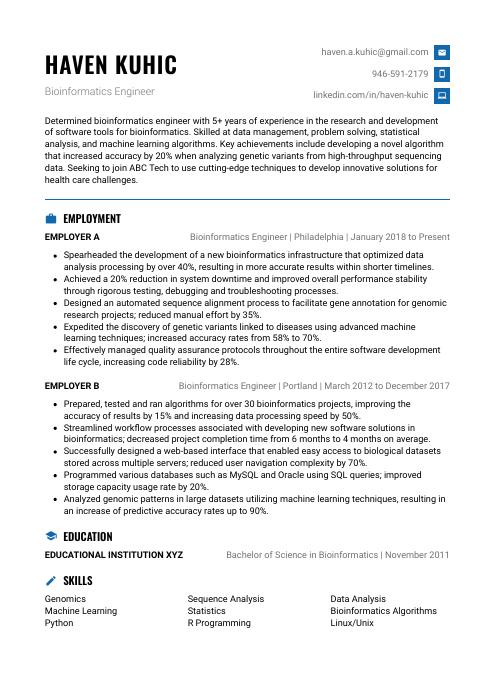 Echidna
Echidna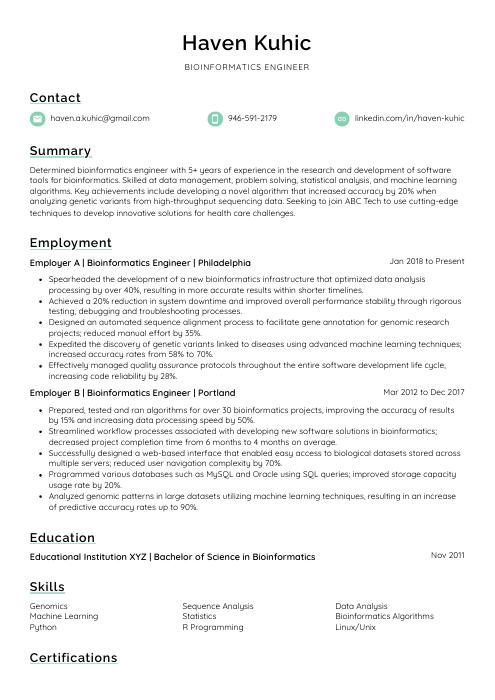 Lorikeet
Lorikeet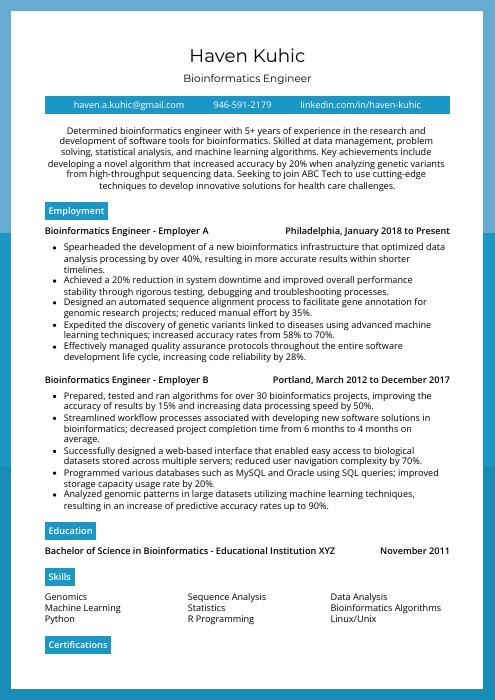 Rhea
Rhea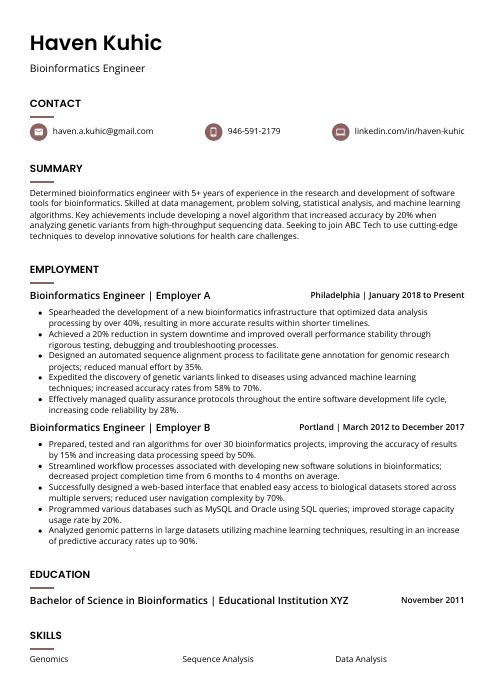 Fossa
Fossa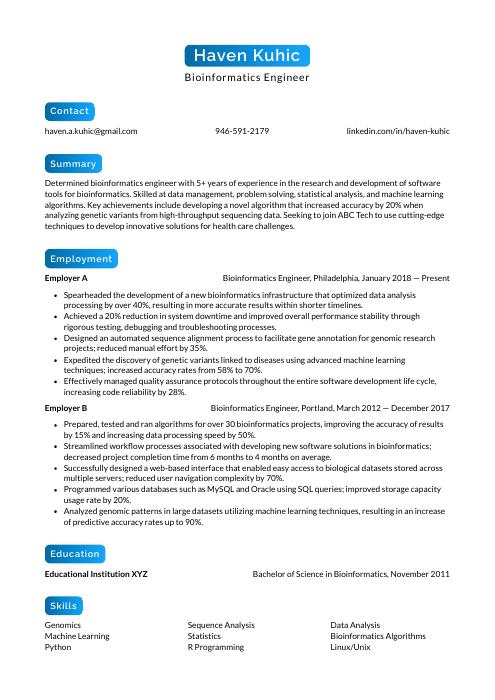 Kinkajou
Kinkajou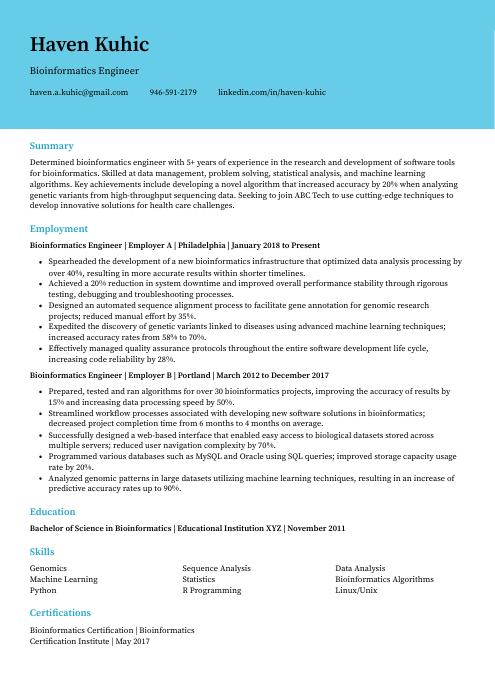 Dugong
Dugong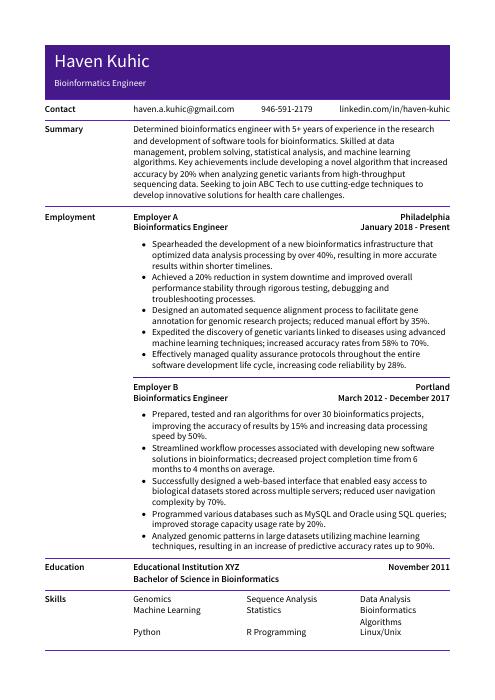 Pika
Pika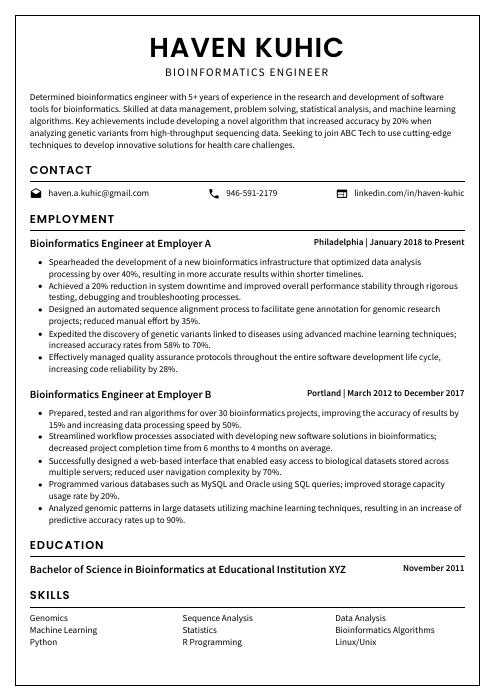 Cormorant
Cormorant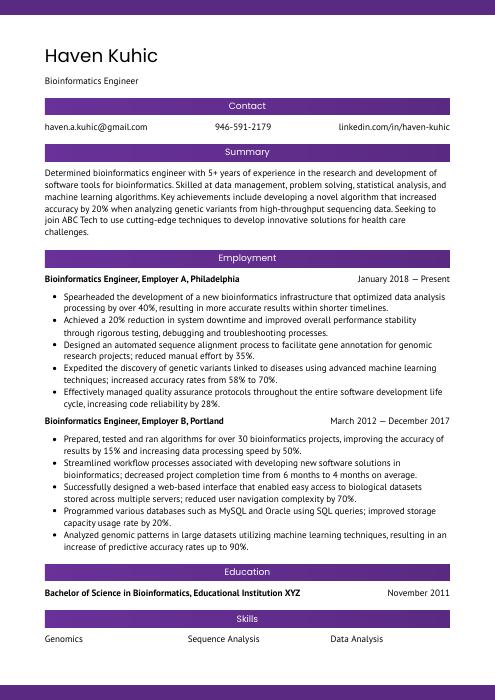 Jerboa
Jerboa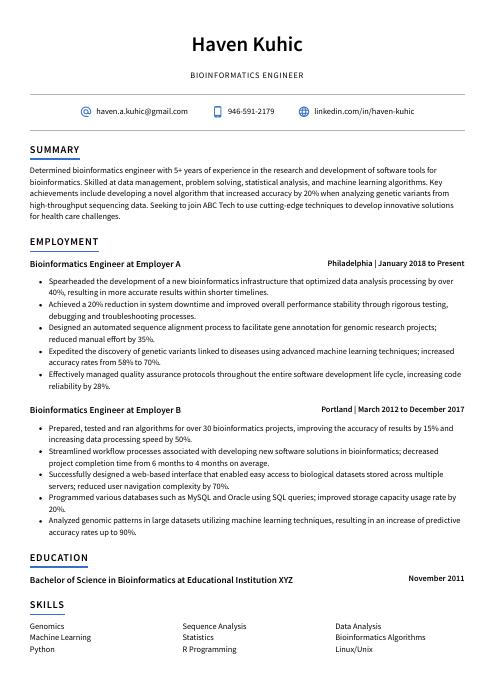 Axolotl
Axolotl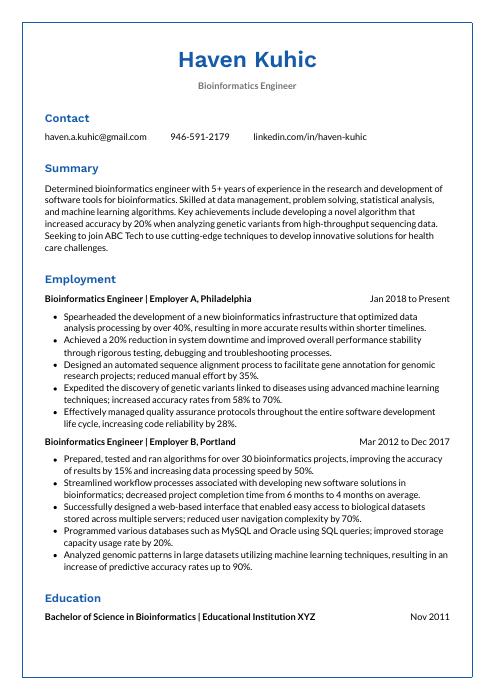 Markhor
Markhor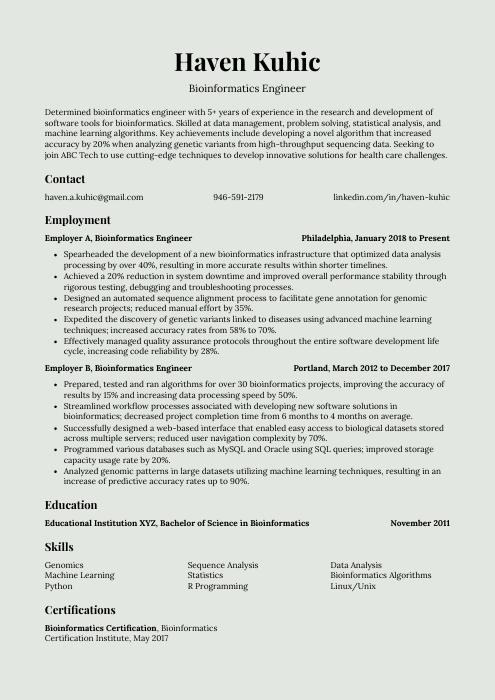 Saola
Saola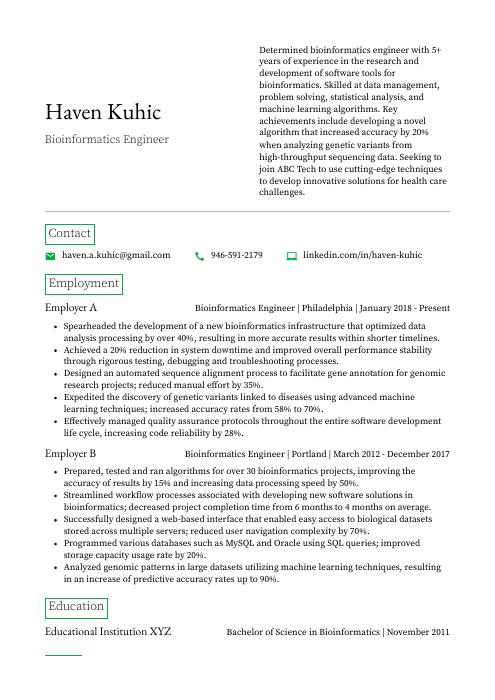 Quokka
Quokka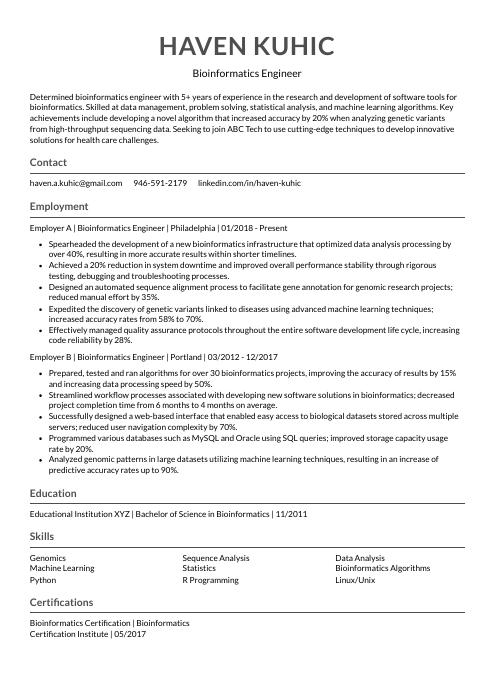 Indri
Indri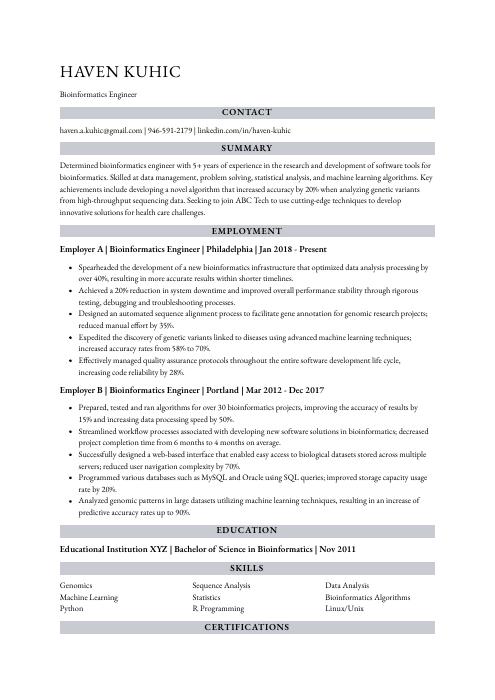 Numbat
Numbat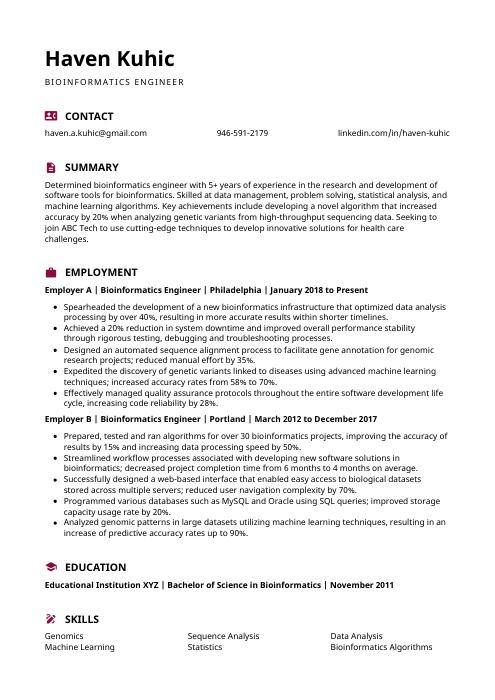 Hoopoe
Hoopoe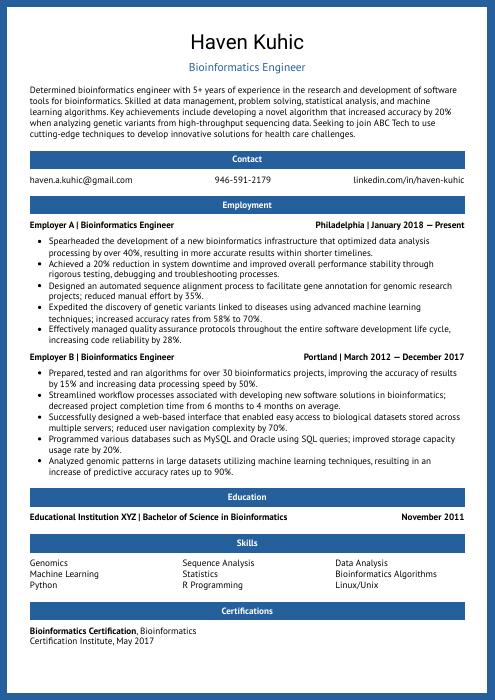 Ocelot
Ocelot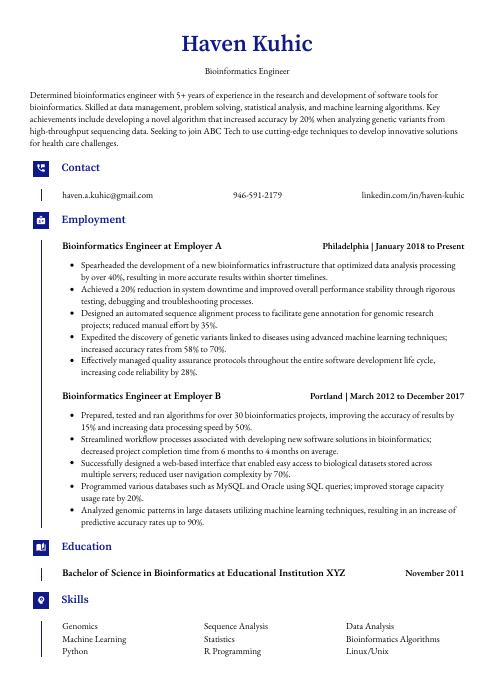 Gharial
Gharial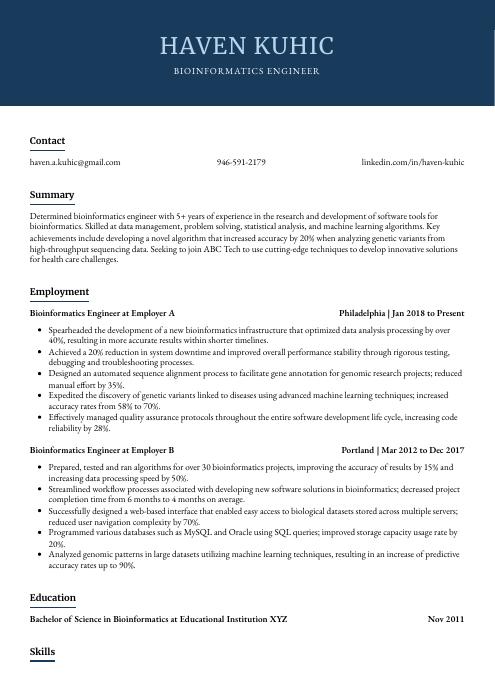 Bonobo
Bonobo Rezjumei
Rezjumei
